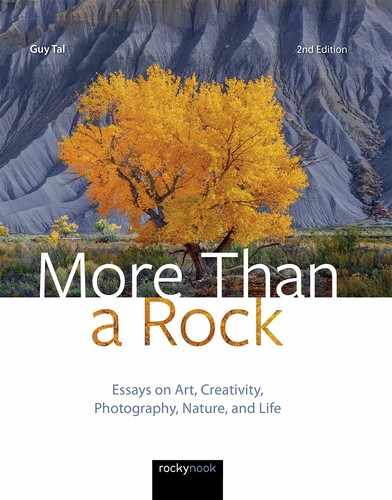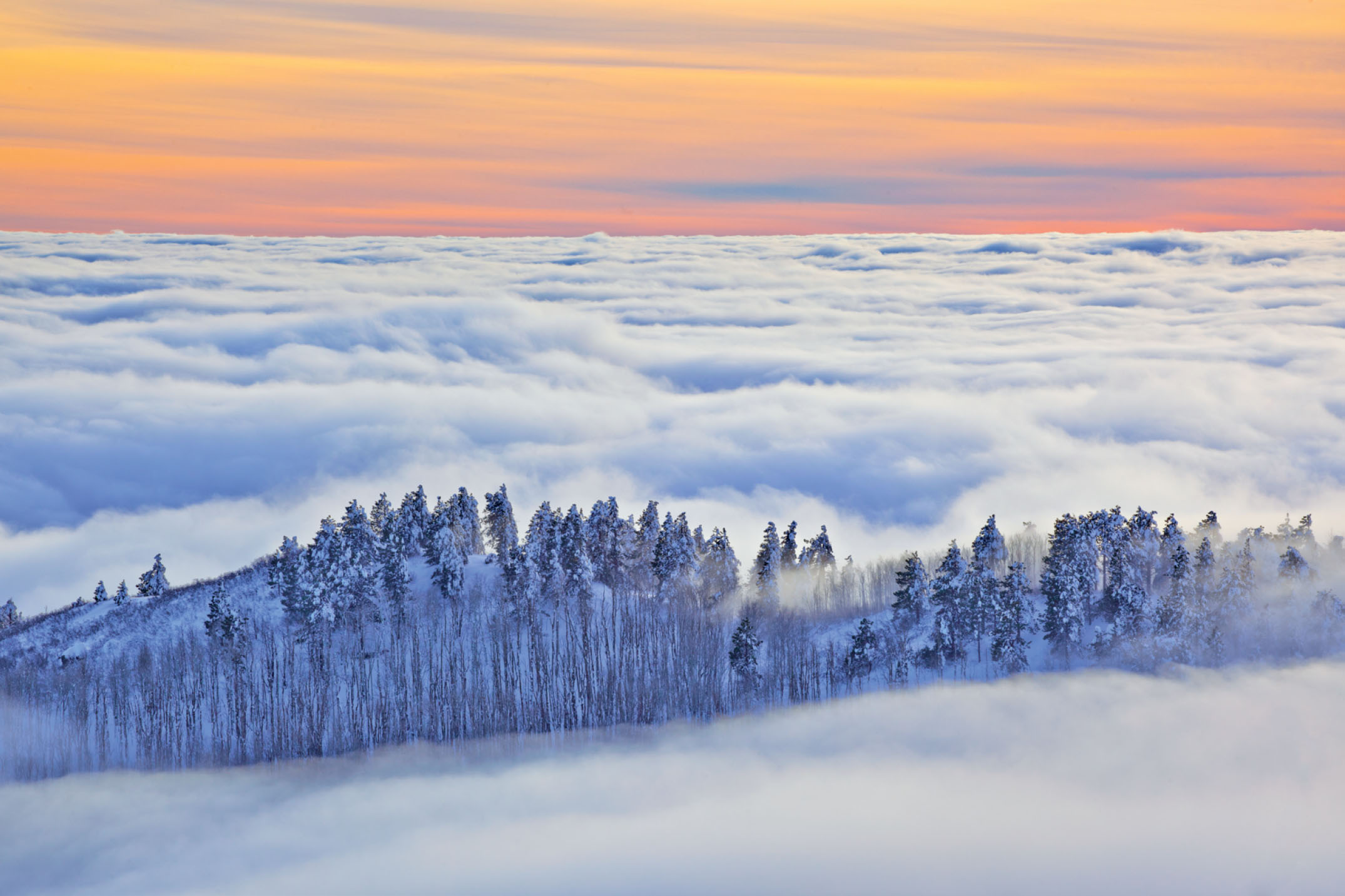A Measure of Worth46
I know of no more encouraging fact than the unquestionable ability of man to elevate his life by a conscious endeavor. It is something to be able to paint a particular picture, or to carve a statue, and so to make a few objects beautiful; but it is far more glorious to carve and paint the very atmosphere and medium through which we look, which morally we can do. To affect the quality of the day, that is the highest of arts. Every man is tasked to make his life, even in its details, worthy of the contemplation of his most elevated and critical hour.
—Henry David Thoreau
I visited the top of my mountain yesterday (and by such characterization I do not mean to imply possession, but rather that this mountain features more prominently than any other in my life story). Up there, some four thousand feet above my home, summer had ended some weeks ago and life had come to a halt in anticipation of the snows that will arrive in short order. Small purple flowers still peek from among the yellowing alpine grasses and lichen-covered rocks, making what they can of the last of the sunlight, as the chill of winter is already palpable. Spruces and firs had ceased sprouting new needles and many animals had already retired to their dens or migrated to warmer climes. Soon, and for several months, no human being will set foot in these highlands until they thaw again next spring. I wandered in blissful solitude among the grassy meadows and stands of alpine conifers in the early afternoon, savoring the last of the desolate terrain before beginning my descent. I stopped before dropping down from the summit plateau, took a deep breath of clear, chilly air, turned my squinting eyes to the sun, and bid farewell to the glowing grasses, to the stalwart trees, and to the crystalline lakes. I will not see them again for several months.
Driving down the steep dirt road, looking over the treetops toward the blue silhouettes of more distant peaks beyond, I had a bird’s-eye view of the vast volcanic plateau below me. Its ripples and undulations, canyons and cliffs, and sparsely vegetated rolling hills told the story of its fiery creation just a few million years ago when this area sat above a hot spot in Earth’s crust, bubbling lava and spewing heated gasses into the air before tectonic forces shifted the plateau away from the burner, allowing it to cool. An ice age followed, and glaciers then carved and polished the land, leaving in their wake just enough fertile soil to sustain a few hardy plants and little more. With the glaciers gone, rains and wind and the cycles of seasons continued to erode the basalt domes. Not too long from now, geologically speaking, this vast elevated expanse will be completely ground into dust and washed down the Colorado River into the Pacific Ocean, never to be seen again as it is today.
Relatively recently (just a few thousand years ago), humans came to these parts—small bands of hunters and gatherers at first, then Fremont and Paiute and Shoshone, followed by Spanish explorers driven by greed and religious zeal. Then came newly minted American explorers, Mormon pioneers, outlaws, and a few refugees who found themselves unfit for the humdrum of cities; all left traces that are visible to the trained eye but are still dwarfed by the immensity of the land. It is at this arbitrary point that I am privileged to see this beautiful place with my own eyes—a point in time as random and fleeting as any other, meaningless by any measure other than to me, and perhaps a few others, within the brief span of a human lifetime.
Descending further, I passed through a forest of fir, spruce, and aspen trees adorned in vibrant autumn colors. Lower still I drove through a forest of large ponderosa pines, its understory padded with a thick layer of long needles and its air rich with the scents of sap and recent rain, before exiting the woods into the fragrant sagebrush plains. The sun was low in the sky, and every leaf and rock and blade of grass was glowing a radiant golden honey in the late-afternoon light, flanked by a wall of ominous steely clouds yet to unleash their showers. By that time I had not seen nor heard another human or machine for several hours. So peaceful and majestic was the scene—the silence and the scents, the light and the flowers, the grasses and the trees, and the distant mountains beyond. I thought about how, year after year, living here has changed me in subtle but undeniable ways. With each season I become calmer, the anxieties of a former life slowly morphing from burdensome worries to distant memories—at times seeming so remote as if they did not actually happen to me but to a character in a book I read.
Earlier in the day I listened to a recorded interview with author Charles “Chuck” Bowden, who passed away in 2014. Gruff yet sensitive, Bowden had a reputation for not pulling punches and for well-earned machismo. He was a tough and gritty journalist with a bleeding heart for justice and beauty, saying it like it is, with power, eloquence, and honesty, and with no flowery fluff. He talked about his career, the state of things political, environmental, and social, and the wisdom of living by one’s convictions and skills even if it means detachment from mainstream society. Among some memorable things he said was this: “Nothing is worth writing about if it doesn’t change the writer.” Hearing these words, I could think of photography, indeed any expressive pursuit, as capable of similar effect. It matters little what medium people choose to express themselves in, so long as they pursue their work with conviction, and incorporate it into their life stories as a meaningful and important instrument for engaging with, exploring, and making sense of the world.
In order for any art to rise to a point where it becomes worthwhile, in the sense of having the ability to transform and elevate not only its audience, but also its creator, a first condition is for it to be taken seriously and practiced with dignity and raw, unbridled emotion. Certainly photography, like writing or poetry, can be serious, whimsical, exalted, banal, poignant, obscure, important, or inconsequential, or any combination thereof, depending on how one chooses to approach it. This is because any medium is just a means to an end, and its powers are only as great as the degree to which that end is worthy. To some it may be social change; historical recording of important events; a way to commune with things, people, and places; a means of discovery, reflection, or articulation of profound notions. Whatever it is, in order to be important, the medium must be treated with respect and reverence, and not as mere hobby, distraction, or craft.
Wynn Bullock wrote, “Photography is no Pollyanna game to me. It is a vital, exciting art form for which I will sacrifice and fight. It deserves anger when it is abused—love when it is respected and made important.” I realized that I seldom see such strong proclamations from artists these days, let alone in mainstream publications, and it stood out to me—large and defiant and humbling—against the backdrop of technical banter, hackneyed milquetoasty rhetoric about the beauty of nature, and artspeak gibberish in so many artist statements. But Bullock’s emotions were genuine and I know them to echo in the hearts of many artists, too. Who cares if it’s photography or painting or writing? If you are a person of principle and passion, any expressive medium will do. It’s not important what you do—it’s important that you believe what you do is important.
My train of thought continued to the value of art, in whatever form. Certainly works of great beauty can be produced (in any media) that possess nothing but aesthetic qualities, offering momentary glimpses of joyous color or attractive subjects, but whose effect is felt only in the mind and only so long as the eyes pause before being distracted by other temptations. Works of importance, on the other hand, may still be beautiful, but their effects are also felt in the heart and the gut and the knees. There is something about them that begins in the mind but that will not be contained there, continuing to permeate the body, to tickle and shift and punch limbs and organs, to quicken the rhythm of blood, to tingle skin and hairs.
Beauty is important, just like sweetness and romance and sunshine are important, and likewise, only in carefully measured proportions, acting as catalyst and delivery system for other, more elevated, things. A heaping dose of beauty with little to balance it in the way of emotion and meaning makes art into kitsch.
Where art is medicine, kitsch is placebo. Kitsch may make its viewers feel better only if they believe it can; but turn attention away for long enough and kitsch is soon forgotten, usurped, or overshadowed by something else. Important art, as opposed to kitsch, makes a lasting impact; its memory may somewhat fade in time but its effect on the psyche is permanent and irreversible. Where kitsch may elicit some joy, only important art can spark such pervasive feelings as yearning, melancholy, awe, majesty, drama, or empathy—both with the art and with its creator.
The value of an image (or an essay or a score of music or any expressive creation) can be measured not only by the effect it has on its viewers but also by the way it affects its maker. By wishing to express more important things in your work, you also become motivated to seek and pursue important things worth expressing. Like all incarnations of love, important works may begin with visual attraction, but once that is exhausted something else must remain—something worthwhile, something that adds meaning and value to the lover’s experience of life itself. Good artists make good art, but the striving to make good art also makes good artists.


